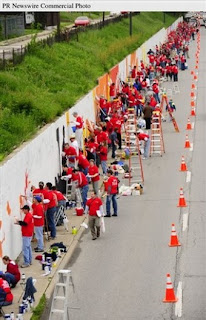For several years I’ve been experimenting with ways to safely dispose of wastewater. The idea is that before we dump our paint water we can put it through a hand made filter with sand and ground charcoal. While this filter doesn’t remove all the toxins from the water, there is a noticeable difference in the color and odor of the water. There are a number of commercially available filtration systems, that are advisable if you are using oil paints, or large amounts of acrylics. Fortunate for printers there are now entire lines of nontoxic organic printing pigments.
Unused paint skins and paints can be taken to a hazardous waste facility. From there at least there will be some degree of remediation. I’ve done some experimenting with dissolving acrylic paints into water over a period of time to try and restore them. To some degree this can be successful, especially with large amount of paints that are still a little crumbly. The pollution caused by our trade takes place in the production, use and disposal of paints, varnishes, gels and other assorted goodies. Hats off to Golden paints for being socially responsible, and for their advanced wastewater treatment facilities.
So if your looking for a place to safely dispose of your toxic art supplies here are some links to Household Hazardous Waste Drop-Off Centers
Berkley

Chicago
Philadelphia
Portland
San Francisco
Seattle
Tucson
Here is a challenge, and eye opener for you, on your next mural project do a carbon count. You can calculate the impact of your project and then make a list of things you need to do to offset the pollution you have created.













